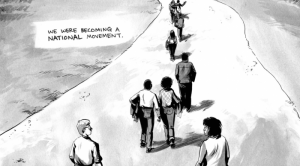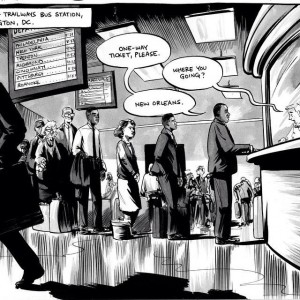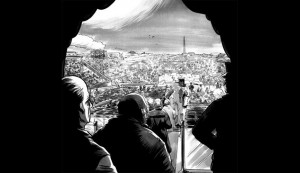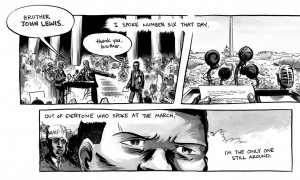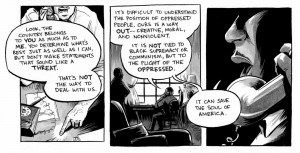Welcome to Using Graphic Novels in Education, an ongoing feature from CBLDF that is designed to allay confusion around the content of graphic novels and to help parents and teachers raise readers. In this column, we examine graphic novels, including those that have been targeted by censors, and provide teaching and discussion suggestions for the use of such books in classrooms.
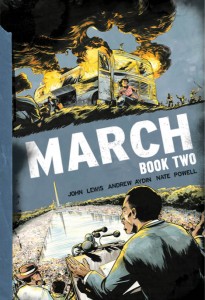 As part of our celebration of Black History Month, this edition of Using Graphic Novels in Education takes a closer look at March: Book Two by John Lewis, Andrew Aydin, and Nate Powell (Top Shelf, 2015). We highlight it here as it brilliantly and sensitively documents the struggle for equal rights and civil liberties. In March, one can read, see, and feel those struggles firsthand. It demonstrates the pain and the hope rippling though the United States in the early 1960s and highlights some of this country’s greatest modern heroes.
As part of our celebration of Black History Month, this edition of Using Graphic Novels in Education takes a closer look at March: Book Two by John Lewis, Andrew Aydin, and Nate Powell (Top Shelf, 2015). We highlight it here as it brilliantly and sensitively documents the struggle for equal rights and civil liberties. In March, one can read, see, and feel those struggles firsthand. It demonstrates the pain and the hope rippling though the United States in the early 1960s and highlights some of this country’s greatest modern heroes.
March: Book Two is the second volume of Representative John Lewis’s graphic novel memoire, co-written with his aide Andrew Aydin and illustrated by Nate Powell. March: Book One was a critically acclaimed bestseller and received the 2013 Coretta Scott King Honor Book Award from the American Library Association and was named one of the best books of 2013 by USA Today, The Washington Post, Publishers Weekly, Library Journal, School Library Journal, Kirkus Reviews, The Horn Book, Comics Alliance, and others. Book Two promises equal success.
March: Book Two details the real-life heroes of the 1960s, from the Civil Rights leaders of SNCC and the SCLC to the black and white protesters who risked life and limb for what was right. In Book Two, Lewis’s story continues with the events that took place on November 10, 1960, in Nashville, Tennessee, as “…our young organization had successfully ended segregation at the lunch counters downtown and turned its attention to fast food restaurants and cafeterias using the same strategy.” It then continues with events that took place in the South between 1960 -1963, culminating with the March on Washington on August 28, 1963.
March: Book Two begins with the SNCC’s success at integrating lunch counters in Nashville and their plans to go further. Through Lewis’s recollections, Aydin’s direction, and Powell’s art, we literally become active viewers as the following events unfold:
- Nashville’s nonviolent protests trying to enter movie theaters;
- CORE (Congress of Racial Equality) sponsored Freedom Ride to demonstrate how effectively the Supreme Court Decision of Boynton v. Virginia — which outlawed segregation and racial discrimination in busses and bus terminals in the previous year — was being upheld (or not);
- SNCC (Student Nonviolence Coordinating Committee)’s “Operation Open City,” designed to promote free employment practices;
- SNCC’s decision (after discussions with Attorney General Robert Kennedy) to register Black voters;
- SNCC’s change in leadership and conflicts over tactics;
- Dr. Martin Luther King, Jr.’s SCLS Birmingham Campaign; and
- the March on Washington on August 28, 1963
In Book Two, we also meet some wonderful — and not-so-wonderful — people. Civil Rights leaders highlighted in this volume include:
- Attorney General Robert Kennedy and his aide, John Seigenthaler (to whose memory the book is dedicated);
- Bayard Rustin, organizer of the March on Washington;
- The Big Six:
- A. Philip Randolph (founder of The Brotherhood of the Sleeping Car Porters and influential Civil Rights and Labor organizer),
- Dr. Martin Luther King, Jr.,
- Roy Wilkins of the NAACP,
- Jim Farmer of CORE,
- Whitney Young of the Urban League, and
- John Lewis of SNCC.
March: Book Two is beautifully written and illustrated. We read, see and feel, the tension in the South and in Washington as events unfold. As Lewis and Aydin narrate Lewis’s story, the power of these events and the tumultuous emotions and reactions they evoked are relayed through Powell’s powerful images. Lewis’s decision to tell his story in graphic novel form is used here to his advantage. The interplay of language, art, and design (choice of panel, font, and use of space) make the story come alive. As readers, we literally feel like we are there, observing, hurting, feeling, and cheering our heroes on.
The language alone is worthy of discussion (see below for details). The story weaves back and forth almost effortlessly between events of the 1960s and the historic inauguration of Barak Obama. Lewis shares famous quotes and snippets of speeches, while relaying his story with quotes, metaphors, and descriptions. The art and page design are instrumental in weaving the story pieces together as a whole and making this tumultuous period in our history come alive.
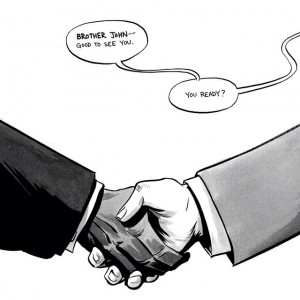 In March: Book Two, Powell’s black and white images empower viewers to comprehend those volatile times as we intimately view Lewis’s recollection of unfolding events. Powell deftly uses black and white contrast, sharp angles, and fonts to relay violent emotions. This is then paired and contrasted with soft, sloping grays for the gentler intervals. We see Black and White protesters treated with equal respect and drawn with soft rounded strokes, while White Southern agitators and Ku Klux Klan members are drown in chilling, brutal, angular strokes. There are beautiful wide-angle shots establishing historic locations, and extensive use of black and white juxtapositions to relate Lewis’s personal turmoil and the drama of these famous and infamous events. Lewis, Aydin, and Powell relay the story in visual and verbal metaphors that are breathtaking.
In March: Book Two, Powell’s black and white images empower viewers to comprehend those volatile times as we intimately view Lewis’s recollection of unfolding events. Powell deftly uses black and white contrast, sharp angles, and fonts to relay violent emotions. This is then paired and contrasted with soft, sloping grays for the gentler intervals. We see Black and White protesters treated with equal respect and drawn with soft rounded strokes, while White Southern agitators and Ku Klux Klan members are drown in chilling, brutal, angular strokes. There are beautiful wide-angle shots establishing historic locations, and extensive use of black and white juxtapositions to relate Lewis’s personal turmoil and the drama of these famous and infamous events. Lewis, Aydin, and Powell relay the story in visual and verbal metaphors that are breathtaking.
Finally, while Lewis introduces us to the giants of the Civil Rights Movement, he never loses touch with the fact that the real heroes were those who sacrificed their goals, their times, and sometimes their lives to advance civil rights. Furthermore, while Lewis was a key player, he modestly downplays his own role in the events. As a result, the book feels real and we feel like we are there with the participants, looking on and urging them forward.
Lewis’s Story in March: Book Two
March: Book Two begins where Book One left off with the inauguration of President Obama. It is now 10:17 a.m. and Lewis is greeted by a colleague in the House of Representatives before heading to the dais. In this opening scene, we’re hit with our first metaphor, as Representative Lewis is told to hurry, to which he replies, “There’s no need to hurry – I’ll end up where I need to be.” As he then proceeds to the dais, we turn the page and find ourselves in Nashville in 1960, being introduced the members of SNCC and their agenda.
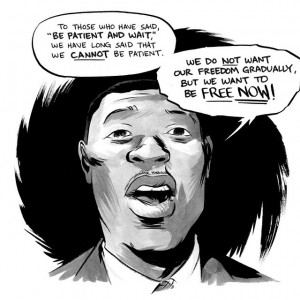 Regardless of whether we’re in 2009 or the heat of the early 1960s, Lewis continues to tell his story in engaging first-person narrative. Each significant episode of Lewis’s life in the 1960s is followed by significant portions of January 20, 2009, at the Obama inauguration.
Regardless of whether we’re in 2009 or the heat of the early 1960s, Lewis continues to tell his story in engaging first-person narrative. Each significant episode of Lewis’s life in the 1960s is followed by significant portions of January 20, 2009, at the Obama inauguration.
As Lewis’s life unfolds in March: Book Two, we learn that with the success of the nonviolent protests at the Nashville lunch counters, the SNCC decides to expand their protests to fast food restaurants and cafeterias and then on to movie theaters. We see that their use of nonviolence is met with increasing uses of violence — from brutal beatings to being subjected to fumigation “used only for killing pests.” And we learn that after a march at a local movie theater, Lewis (along with 25 others) spent his 21st birthday (February 21, 1961) in jail.
In the next episode, Lewis details his role in the CORE Freedom Ride that was held one year after the Supreme Court Decision of Boynton v. Virginia. The ride was intended to determine whether Southern states were upholding the desegregation of busses and bus stations. Lewis notes that those accepted on the ride (there was an application process), “…learned local and state laws. Lawyers lectured us on our rights under the Boynton Decision, and what could be done if those rights were denied.” A few pages later, we learn that they decided, “If there is an arrest. We will ACCEPT that arrest, and if there is violence we will ACCEPT that violence without responding in kind…[BUT] We will NOT pay fines because we feel that, by paying money to a segregated state, we would help it perpetuate segregation.” Over the following pages, we learn of the numerous incidents of violence that protestors faced, including brutal beatings, explosions, and incarceration as they rode from Washington, D.C. toward New Orleans.
During the Freedom Ride campaign, which started out from Washington D.C. on May 4, 1961, we meet Attorney General Robert Kennedy and his aide John Seigenthaler and learn to what extent they worked to protect the Freedom Riders’ rights and to uphold the Boynton Decision. We also meet Dr. Martin Luther King, Jr. as he came down to Montgomery, Alabama, to join the protesters holed up in Ralph Abernathy’s First Baptist Church on May 21, 1961. We then follow the Freedom Riders through more violence and their arrest and imprisonment on June 15, 1961 at the Mississippi State Penitentiary, a.k.a. “Parchman Farm… the stuff of legends — dark legends.” Lewis notes that at “the Farm,” they were told to take off their shoes and clothing. “It was dehumanizing, as was our being forced to shave all of our facial hair as part of an effort to strip away our dignity — our very HUMANITY.”
From the Freedom Ride, we then get a peak at the SNCC and the growing pains it was enduring. As Lewis notes, “Our cause remained the same, but our methods were in question…More than a few of the 250 SNCC representatives in Atlanta that weekend argued that it should be acceptable to strike back if you’re hit.” He later notes — using an awesome visual metaphor in which the text is written inside a balled-fist punching Lewis in the face — that, “By the end of 1962, you heard people questioning whether SNCC should even BE a multi-racial organization.”
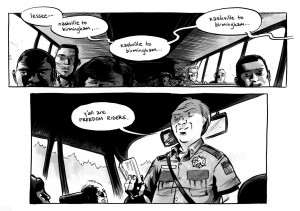 While Lewis remained with the SNCC, it was Dr. Martin Luther King Jr.’s SCLC that continued sponsoring nonviolent protests, and Lewis describes some of the more prominent ones, including the Birmingham Campaign (which began April 9, 1963), the Birmingham Children’s March (which began May 2, 1963), and President Kennedy’s response to the violence in “Birmingham and elsewhere.”
While Lewis remained with the SNCC, it was Dr. Martin Luther King Jr.’s SCLC that continued sponsoring nonviolent protests, and Lewis describes some of the more prominent ones, including the Birmingham Campaign (which began April 9, 1963), the Birmingham Children’s March (which began May 2, 1963), and President Kennedy’s response to the violence in “Birmingham and elsewhere.”
It was Lewis’s leadership role with the SNCC, however, that got him an invitation to go to the White House with other leaders to discuss President Kennedy’s proposed Civil Rights Bill. The administration’s concerns about the impending March on Washington were also discussed. Lewis’s SNCC leadership role meant he was included among the “Big Six,” along with A. Philip Randolph, Dr. Martin Luther King, Jr., Roy Wilkins of the NAACP, Jim Farmer (CORE), and Whitney Young (of the Urban League). It was the Big Six, along with Bayard Rustin, who organized and led the March on Washington. Book Two ends with snippets of speeches and of the controversy John Lewis’s speech caused.
To help readers more fully feel and understand those times, Lewis, Aydin, and Powell sensitively relate how painful this period was for everyone. As in the first book, Lewis narrates the pivotal events in his life through gentle conversation, while Aydin’s direction and Powell’s art enable us to interpret and feel his emotions and the resulting consequences.
 In short, Lewis’ story is told through gentle narration and vibrant art in a way that empowers us to relive it with him. As a result, readers better understand the social unrest of the early 1960s, the growing pains of the Civil Rights Movement, and the increasing need of coordination among local, state, and federal governments to address these issues.
In short, Lewis’ story is told through gentle narration and vibrant art in a way that empowers us to relive it with him. As a result, readers better understand the social unrest of the early 1960s, the growing pains of the Civil Rights Movement, and the increasing need of coordination among local, state, and federal governments to address these issues.
Throughout March: Book Two, Lewis, Aydin, and Powell relay:
- The effects of segregation and the painful and all-too-gradual upheaval of the Jim Crow laws in 1960s;
- The power and struggles of social gospel and non-violent protest in times of civic unrest;
- The growing pains of the Civil Rights Movement, during which some wanted to meet violence with violence, forgoing their earlier nonviolent dictum;
- The fights fought and barriers overcome by Black and White champions of the Civil Rights;
- The power of the peoples’ voice in a democratic republic;
- The powers and limits of local and national government, especially in times of civic unrest;
- The different ways people find the courage to stand up and fight for their rights;
- The power words can have, be they in print or oratory, as well as the power image can play in communicating passions, events, and perspectives.
TEACHING/DISCUSSION SUGGESTIONS:
- Chart the progress of the Civil Rights movement through March Book One and Book Two. Discuss:
- What was gained?
- What was lost?
- What were the costs to states/cities/individuals?
- What were the pivotal decisions made that helped shape the changing political and social landscapes?
- Research the Supreme Court Decision in Boynton v. Virginia. Compare Lewis’ account to accounts found in newspapers and magazines of the time.
- Research and discuss CORE’s Freedom Ride. (See below for links to relevant resources.) Discuss:
- What participants went through just to get there;
- Different ways people reacted and reported this incident (newspapers, magazines, personal accounts).
- What were some of the social and political issues that city officials faced as the Riders approached their jurisdiction?
- Research, present and discuss the lives and roles of the Civil Rights Movement leaders mentioned in this book:
- James Farmer (CORE);
- Freedom Riders: Joe Perkins, Jim Peck, Elton Cox, Dr. Walter Bergman, Jimmy McDonald, Charles Person, Ed Blankenheim, Genevieve Hughes, Albert Bigelow, Hank Thomas, Paul Brooks, Jim Swerg, and Salynn McCollum;
- Attorney General Robert Kennedy;
- Robert Kennedy’s aide, John Seigenthaler (to whom the second book was dedicated);
- Dr. Martin Luther King, Jr.;
- Ralph Abernathy and his First Baptist Church;
- Fred Shuttleworth;
- Stokely Charmichael;
- A. Philip Randolph, founder of the Brotherhood of Sleeping Car Porters;
- Roy Wilkins of the NAACP;
- Whitney Young of the Urban League;
- Malcolm X;
- Bayard Rustin.
- Research, present, and discuss the lives and roles of those who violently opposed the Civil Rights Movement:
- Eugene “Bull” Connor;
- Alabama Governor John Patterson;
- Alabama Governor Corely George Wallace, Jr.;
- Fred Jones, Superintendent Mississippi State Penitentiary (a.k.a. “Parchman Farm”);
- Mississippi Governor, Ross Barnett (1960 – 1964);
- South Carolina Senator Storm Thurmond;
- the Ku Klux Klan.
- Research, present, and discuss the different sides of the following events that shaped the Civil Rights Movement. Discuss how each shaped and affected the world around them:
- Theater protests in the 1960s;
- CORE’s Freedom Ride;
- The trial of E.H. Hurst, member of the Mississippi State Legislature who shot a local black farmer named Herbert Lee, and the resulting protest led by Bob Moses, Charles McDew, and Bob Zellner;
- The summer protest at the swimming pool in Cairo, Illinois, and the powerful photograph taken for the SNCC by Danny “Dandelion” Lyon;
- Protest march at Zion Hill Baptist Church in Birmingham, Alabama, on April 12, 1963, which was led by Dr. Martin Luther King, Jr. and led to his imprisonment and his “Letter from Birmingham Jail”;
- Jim Bevel and the SCLC’s Birmingham Children’s March on May 2-3, 1963.
- Read, evaluate and debate the merits and demerits of President Kennedy’s Civil Rights Bill, keeping in mind the social and political environments in which is was proposed.
- Read, evaluate, compare, and contrast the six speeches made at the March on Washington
 Cultural Diversity, Civic Responsibilities, and Social Issues
Cultural Diversity, Civic Responsibilities, and Social Issues
- Analyze how the book’s different characters dealt with racism. Ask students how they might deal with racist comments, practices and restrictions.
- Discuss what it must have felt like to be excluded from busses, shops, and from receiving community services.
- Discuss different options and means of protest. How have these options changed today, if at all, compared to the options Lewis and his colleagues had in the 1960s?
- Research, present, and discuss the personal backgrounds, public struggles, and the articles and speeches of local and national figures of the Civil Rights Movement.
- Define and discuss “racism.”
- Discuss the different instances of discrimination and racism presented throughout the book. Discuss instances of racism today on local, national, and international scenes.
- How is racism the same / different across time and geographic locations (nationally and / or internationally)?
- How has racism changed today, if at all?
- Discuss how hurtful racism can be to those targeted as well as to the general population.
- Discuss how racism has influenced, shaped, and determined national and international policies and politics.
- Discuss what can be done today to fight racism and discrimination and ways students can help.
- On pages 96-97, Lewis notes that, “Racism in Mississippi was different than in Alabama… They tried to hide the open violence that was so publicly allowed to take place in Birmingham, Montgomery and elsewhere… Instead, much of the means of enforcing segregation came through economic and political pressure organized by a group called the White Citizens’ Council. Sort of like a businessman’s Ki Klux Klan.”
- Research and compare the incidents and strategies of the White Citizen’s Council versus the Ku Klux Klan.
- Debate the effectiveness or the destructive qualities of each.
- On page 109, as the Freedom Ride campaign continued, Lewis writes, “By the end of the summer, dozens more busses carried the nation’s daughters and sons into the heart of the Deep South to carry on the work we began. The fare was paid in blood, but the Freedom Rides stirred the national consciousness and awoke the hearts and minds of a generation… We were becoming a national movement.” Discuss how and why national movements “become.”
- On page 114, Lewis notes that, “No state showed us what we were up against more than Mississippi. Nearly 90% of the state’s black families lived below the poverty line, and only 5% of eligible black voters were registered….” Research and compare:
- The populations of various Black and White populations in Southern states in the 1960s and now.
- The populations and proportions of Black and White populations in Southern States that were registered voters.
- Discuss if / how things have changed and why / why not.
- Toward the end of the book, at the March on Washington, many had issues with Lewis’s original speech. As a result, he was pressured to cut out passages he felt quite passionate about. Discuss and debate the needs of compromise in public offices and speeches as well as in legislation.
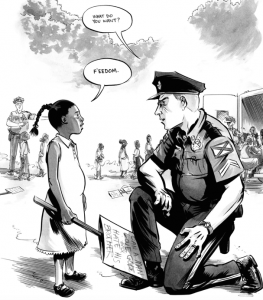 Language, Literature, and Language Usage
Language, Literature, and Language Usage
- Search for, define, and discuss the book’s use of idioms, hyperbole, and simile to better express opinions, feelings, and cultural expressions. Discuss how effective they are in communicating a specific message or a specific point in time. For example, you may want to discuss:
- On pages 6-7, as the U.S. House Representatives line up for President Obama’s inauguration (2009), a colleague approaches John Lewis, telling him he should hurry to get to the front, and John Lewis replies, “There’s no need to hurry, I’ll end up where I need to be.” This then segues into Lewis’ past. Discuss the use of text and image to create this metaphor.
- On page 91, Lewis recounts Dr. Martin Luther King Jr.’s statement when explaining why he would not be joining the Freedom Riders, “…I think I should choose the time and the place of my Golgotha.”
- On page 99, “Parchman (Farm, Mississippi State Penitentiary) was the stuff of legends — dark legends. 21,000 acres of bullwhip-wielding guards and human bondage.”
- On page 109, as the Freedom Ride campaign continued, Lewis writes, “By the end of the summer, dozens more busses carried the nation’s daughters and sons into the heart of the Deep South to carry on the work we began. The fare was paid in blood, but the Freedom Rides stirred the national consciousness and awoke the hearts and minds of a generation… We were becoming a national movement.”
- On pages 140-141, in President Kennedy’s address, Lewis notes, “…The events in Birmingham and elsewhere have so increased the cries for equality that no city or state legislative body can prudently ignore them. The fires of frustration and discord are burning…It is time to act… A great change is at hand, and our task — our obligation — is to make that revolution, that change peaceful and constructive for all.”
- On page 171, in his March on Washington speech, Lewis notes, “By the force of our demands, our determination, and our numbers, we shall splinter the segregated South into a thousand pieces, and put them together in the image of God and democracy…”
- On page 172, Lewis notes about Dr. Martin Luther King Jr.’s speech, “His words carried through the air like arrows… moving to a climactic refrain the world would never forget.”
- Compare and contrast the language used in the various speeches given at the March on Washington August 28, 1963.
- Have students collect family stories (oral, written, and / or photographed) of the 1960s and the Civil Rights Movement, marches, and protests, and / or stories of racism and segregation. [Note there were and still are incidents of racism and segregation experienced by minority and immigrant families as well. To include all your students, you may want to expand your discussion to racist incidents directed at various targeted groups.]
- You may have students write two versions of these stories as a means of reflecting on language use and idioms that are time or era specific.
- Have them write one version as if they are there in the 1960s, as a first-person narrative; and then writing it now, reflecting back. How does the language and the story differ?
Critical Thinking and Inferences
The authors make many inferences in this book both with language use and through imagery. You may want to discuss the following uses of inference:
- On page 22, Lewis recalls a conversation with the SNCC’s Central Planning Committee, debating whether nonviolent protests should be halted in response to the increasing violence that met them. Lewis notes that Reverend Will Campbell argued, “How can it be the right thing to do, to continue putting young people in harm’s way?” Lewis replies adamantly that they’re going to march regardless, and Campbell responds, “What it comes down to is that this is just a matter of pride to you. This is about your own stubbornness. Your own sin.” Debate the pros and cons on continuing non-violent protest when it’s met with violence, and discuss Campbell’s intent in what he said. Was he correct? Why or why not?
- Discuss the merits and intent of the Freedom Riders’ strategy (p. 36): “We will accept that arrest and if there is violence we will accept that violence without responding in kind We will NOT pay fines because we feel that, by paying money to a segregated state, we would help it perpetuate segregation.”
- Discuss Dr. King’s word to President Kennedy when he says (pg.95): “It’s difficult to understand the position of oppressed people. Ours is a way out — creative moral, and nonviolent. It is not tied to Black Supremacy or Communism, but to the plight of the oppressed. It can save the soul of America.”
- Discuss Dr. Martin Luther King’s intent when he wrote: “…I submit that an individual who breaks a law that conscience tells him is unjust, and who willingly accepts the penalty of imprisonment in order to arouse the conscience of the community over its injustice, is in reality expressing the highest respect for law” in his Letter from Birmingham Jail.
- At the Birmingham Children’s March on May 2-3, 1963, we see a police officer asking a young girl (p. 135), “What do you want?” She responds, “F’eedom.” Discuss Lewis’ comments as he notes, “It was an embarrassment to the city.”
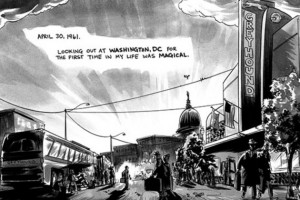 Modes of Storytelling and Visual Literacy
Modes of Storytelling and Visual Literacy
In graphic novels, images are used to relay messages with and without accompanying text, adding additional dimension to the story. Compare, contrast, and discuss with students how images can be used to relay complex messages. Powell is a master at combining text, image, shading, and design work to communicate passions, events, and powerful messages. Here are lesson suggestions to help students learn and appreciate this skill:
- Have students hunt for examples of how Aydin and Powell use text, image, and design to relay complicated messages and issues, or simply present your own instances and have students analyze them. For example:
- Discuss how effortlessly the transitions are made between past and present. Analyze how this is done.
- On pages 70-71, Lewis relays how Attorney General Robert Kennedy arranged for the Freedom Ride to continue through Alabama. Evaluate and discuss how this is done through images, text, and panel design.
- On pages 79-82, the reader goes from the past, to the present, and then back to the past, with “My Country ‘Tis of Thee” sung throughout the transitions, adding multiple layers of meaning. Discuss how this is done and the intent of the authors in doing this.
- On page 115, Lewis recalls the incident in Liberty, Mississippi, where a local Black farmer, Herbert Lee, was shot dead by E.H. Hurst. Discuss how Powell’s use of gray on black relays the events.
- On page 123, discuss the powerful image in which Lewis is punched in the face with the text, “By the end of 1962, you heard people questioning whether SNCC should even BE a multi-racial organization.”
- On page 130 ,the authors relay a powerful passage from Dr. King’s Letter from Birmingham Jail. Discuss the use of black, white, and gray as well as the page design to brilliantly relay the lighter message of hope from the dark depths of prison.
- Have students hunt for visual and verbal examples of racism, discrimination, and / or segregation, comparing how they are relayed through language and how they are relayed through image. Discuss the impact of these various forms of communication.
- For parts of the story, Powell relays his images against a black background while others are relayed against a white background. Chart when he does each, and discuss why this might be. Discuss how page design and backgrounds help communicate the story and its messages.
- Compare and contrast how the authors help us distinguish between words that were sung, spoken, preached, and / or heard over the radio.
- Discuss how Powell uses art between pages 60-63 to relay the passage of time in Lewis’ life and narrative.
Suggested Prose Novel and Poetry Pairings
For greater discussion on literary style and/or content here are some prose novels and poetry you may want to read with The Silence of Our Friends
- March: Book One (August 2013): A graphic novel by Congressman John Lewis, Andrew Aydin, and Nate Powell. This first volume spans Lewis’ youth in rural Alabama, his meeting with Dr. Martin Luther King Jr., the birth of the Nashville Student Movement, and their battle against segregation. NOTE: This book has an awesome teacher’s guide too.
- Kingby Ho Che Anderson (Fantagraphics, 1993; reprint edition 2010): A beautifully illustrated award-winning biography integrates interviews, narrative, sketches, illustrations, photographs, and collages that piece together an honest look at the life, times, tragedies, and triumphs of Martin Luther King, Jr. For King, Anderson won the Harvey Award for Best New Talent (1991), Best Graphic Album (1993), and Parents’ Choice Award (1995).
- The Silence of Our Friends by Mark Long, Jim Demonakos, and Nate Powell (First Second Books, 2012): A semi-autobiographical story of Mark Long’s childhood experiences in Houston, Texas, centering around the Texas Southern University student boycott after the Student Nonviolent Coordinating Committee (SNCCC) was banned from its campus in 1968.
- P.S. Be Eleven by Rita Williams-Garcia: Winner of the Loretta Scott King Award (2013) and sequel to One Crazy Summer (Newbery Honor Book) that reveals race, gender, and political issues of the late 1960s.
- I Have a Dream: Writings and Speeches That Changed the World by Martin Luther King, Jr.: Martin Luther King’s “ – text of his famous speech (see link below).
- Martin’s Big Words: The Life of Dr. Martin Luther King Jr. by Doreen Rappaport and Bryan Collier (illustrator): An extraordinary picture-book biography incorporating narrative, famous quotes from Dr. King and powerful collage and watercolor illustrations introducing King’s words and legacy to younger readers.
Common Core State Standards:
March: Book Two is full of advanced vocabulary, simile, slang, idioms, and oratory. It promotes critical thinking, introduces multiple national American heroes, and is a coming of age story laden with issues of identity, justice, and friendship. Furthermore, in graphic novel format, it provides verbal and visual story telling that addresses multi-modal teaching, and meets Common Core State Standards. As this book can and should be used by students in middle grades through high school, we relate below how it meets the Common Core Anchor Standards:
- Knowledge of Language: Apply knowledge of language to understand how language functions in different contexts, to make effective choices for meaning or style, to comprehend more fully when reading or listening.
- Vocabulary Acquisition and Use: Determine or clarify the meaning of unknown and multiple-meaning words and phrases by using context clues, analyzing meaningful word parts, and consulting general and specialized reference materials; demonstrate understanding of figurative language, word relationships, and nuances in word meaning; acquire and use accurately a range of general academic and domain-specific words and phrases sufficient for reading, writing, speaking and listening at the college and career readiness level.
- Key ideas and details: Reading closely to determine what the texts says explicitly and making logical inferences from it; citing specific textual evidence when writing or speaking to support conclusions drawn from the text; determining central ideas or themes and analyzing their development; summarizing the key supporting details and ideas; analyzing how and why individuals, events, or ideas develop and interact over the course of the text.
- Craft and structure: Interpreting words and phrases as they are used in a text, including determining technical, connotative, and figurative meanings and analyzing how specific word choices shape meaning or tone; analyzing the structure of texts, including how specific sentences, paragraphs and larger portions of the text relate to each other and the whole; Assessing how point of view or purpose shapes the content and style of a text.
- Integration of knowledge and ideas: Integrate and evaluate content presented in diverse media and formats, including visually…as well as in words; delineate and evaluate the argument and specific claims in a text, including the validity of the reasoning as well as the relevance and sufficiency of the evidence; analyze how two or more texts address similar themes or topics in order to build knowledge or to compare the approaches the authors take
- Range of reading and level of text complexity: Read and comprehend complex literary and informational texts independently and proficiently
- Research to Build and Present Knowledge: Conduct short as well as more sustained research projects based of focused questions, demonstrating understanding of the subject under investigation; gather relevant information from multiple print and digital sources, assess the credibility and accuracy of teach source, and integrate the information while avoiding plagiarism; draw evidence from literary or informational texts to support analysis, reflection, and research.
- Comprehension and collaboration: Prepare for and participate effectively in a range of conversations and collaborations with diverse partners, building on others’ ideas and expressing their own clearly and persuasively; integrate and evaluate information presented in diverse media and formats, including visually, quantitatively and orally; evaluate a speaker’s point of view, reasoning, and use of evidence and rhetoric.
- Presentation of knowledge and ideas: Present information, findings, and supporting evidence such that listeners can follow the line of reasoning and the organization; adapt speech to a variety of contexts and communicative tasks, demonstrating command of formal English when indicated or appropriate.
This book and related discussions also cover the following themes identified by The National Council for the Social Studies:
- Culture and Cultural Diversity — “…students need to comprehend multiple perspectives … to consider the strengths and advantages that this diversity offers to the society in general and to their own growth…to analyze the ways that a people’s cultural ideas and actions influence its members…”
- Time, Continuity, and Change — “…facilitate the understanding and appreciation of differences in historical perspectives and the recognition that interpretations are influenced by individual experiences, societal values, and cultural traditions… examine the relationship of the past to the present and extrapolating into the future… provide learners with opportunities to investigate, interpret, and analyze multiple historical and contemporary viewpoints within and across cultures related to important events, recurring dilemmas, and persistent issues, while employing empathy, skepticism, and critical judgment…”
- Individual Development and Identity — “…describe how family, religion, gender, ethnicity, nationality, socioeconomic status, and other group and cultural influences contribute to the development of a sense of self…have learners compare and evaluate the impact of stereotyping, conformity, acts of altruism, discrimination, and other behaviors on individuals and groups…”
- Individuals, Groups, and Institutions — “…help learners understand the concepts of role, status, and social class and use them in describing the connections and interactions of individuals, groups, and institutions in society…analyze groups and evaluate the influence of institutions, people, events, and cultures in both historical and contemporary settings…identify and analyze examples of tensions between expressions of individuality and efforts of groups and institutions to promote social conformity…”
- Power, Authority, and Governance — “…understanding the historical development of structures of power, authority, and governance and their evolving functions in contemporary American society… enable learners to examine the rights and responsibilities of the individual in relation to their families, their social groups, their community, and their nation… examine issues involving the rights, roles, and status of individuals in relation to the general welfare…explain conditions, actions, and motivations that contribute to conflict and cooperation within and among nations…challenge learners to apply concepts such as power, role, status, justice, democratic values, and influence…”
- Civic Ideals and Practices — “…assist learners in understanding the origins and continuing influence of key ideals of the democratic republican form of government, such as individual human dignity, liberty, justice, equality, and the rule of law…analyze and evaluate the influence of various forms of citizen action on public policy…evaluate the effectiveness of public opinion in influencing and shaping public policy development and decision-making…”
ADDITIONAL RESOURCES:
- March: Book One Teacher’s Guide can be downloaded at http://www.topshelfcomix.com/contact/teachers-guidehttp://www.topshelfcomix.com/contact/teachers-guidehttp://www.topshelfcomix.com/contact/teachers-guide
- PBS’ American Experience: Civil Rights Movement Non-Violent Protests — contains related videos, photographs, interviews, press coverage and primary sources, milestones, reflections, notes for teachers, and more
- Martin Luther King, Jr. I Have a Dream speech (text and audio)
- http://www.loc.gov/teachers/classroommaterials/themes/civil-rights/exhibitions.html — multimedia resources from the Library of Congress that support the teaching about civil rights
- Historical places of the civil rights movement — We Shall Overcome: A National Register of Historic Places Travel Itinerary with an introduction, itinerary maps, list of sites and links to learn more
- http://www.academicinfo.net/africanamcr.html — civil rights history resource
- http://www.pbs.org/teachers/thismonth/civilrights/index1.html — teaching ideas for teaching the civil rights movement in American literature (all grade levels)
- http://www.crmvet.org/poetry/poemhome.htm — poems of the Freedom Movement
- Notes and brochures of the SCLC’s Crusade for Citizenship found now at the King Center.
- For a more interactive link on the Freedom Rides, a production of “American Experience and PBS offers links retracing the route of the ride; first-person accounts of the rides through biographies, photos and film clips; a timeline of the events; and a discussion of the issues.
- Overview of the Freedom Rides from the History Channel
- Birmingham’s Children’s March via pbs.com with a video and outstanding audio reports (with detailed history background and personal testimonies and recollections of individual marchers) and additional links.
- Birmingham’s Children’s Crusade— Outstanding link with video and very powerful photos, background and personal accounts, and additional links by Kim Gilmore at biography.com
- PBS explores Project C and the Birmingham Campaign with photos and film clips; provides President Kennedy’s response to the violence in Birmingham, a segment on Birmingham and the Children’s March, and more.
- A transcript of President Kennedy’s press conference regarding “An Ugly Situation in Birmingham” May 1963.
- The History Channel’s interactive link on The March on Washington — With video clips of King’s “I Have a Dream” speech, the March from Selma to Montgomery, background on the March on Washington, and information on how King’s speech became an impromptu addition.
- An Oral History of the March on Washington with interviews by Michael Fletcher and videos by Ryan R. Reed through Smithsonian.com
- A guide for students on how to conduct oral history interviews with samples of American slave narratives and other primary resource sets
- http://www.history.com/search?q=civil+rights+movement&x=0&y=0 – History channel list of links and resources
- http://www.goodreads.com/shelf/show/civil-rights-movement and http://www.slj.com/2013/01/books-media/collection-development/focus-on-collection-development/civil-rights-everyday-heroes-focus-on-january-2013/ – provides extensive lists for further reading on the civil rights movement for students of varying ages and reading levels.
Meryl Jaffe, PhD teaches visual literacy and critical reading at Johns Hopkins University Center for Talented Youth OnLine Division and is the author of Raising a Reader! and Using Content-Area Graphic Texts for Learning. She used to encourage the “classics” to the exclusion comics, but with her kids’ intervention, Meryl has become an avid graphic novel fan. She now incorporates them in her work, believing that the educational process must reflect the imagination and intellectual flexibility it hopes to nurture. In this monthly feature, Meryl and CBLDF hope to empower educators and encourage an ongoing dialogue promoting kids’ right to read while utilizing the rich educational opportunities graphic novels have to offer. Please continue the dialogue with your own comments, teaching, reading, or discussion ideas at meryl.jaffe@cbldf.org and please visit Dr. Jaffe at http://www.departingthe text.blogspot.com.
Help support CBLDF’s important First Amendment work in 2015 by visiting the Rewards Zone, making a donation, or becoming a member of CBLDF!
All images (c) John Lewis, Andrew Aydin, and Nate Powell.

